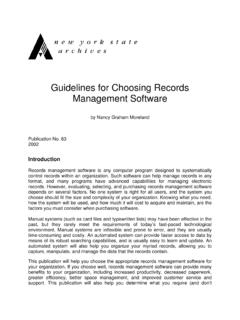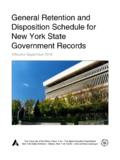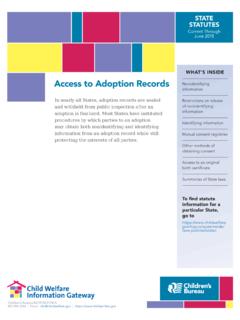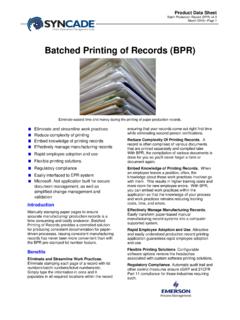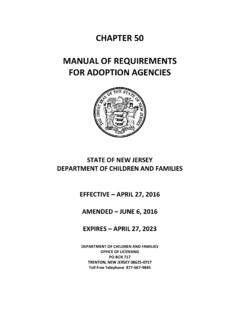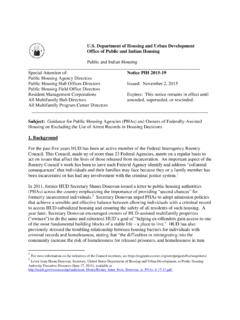Transcription of New York State Archives - Publication 41 - Retention and ...
1 Retention and Disposition of Records: How Long to Keep Records and How to Destroy Them by Geof Huth Archives Technical Information Series #41 2002 Introduction You must regularly destroy unnecessary records if you want to do your work as efficiently as possible. Many people don t learn this lesson until they ve spent a month clearing obsolete records out of a storage room. It s a lesson that others have learned when they found themselves unable to respond to legal subpoenas or discovery actions. But you can avoid learning this lesson the hard way by finding out how to use records Retention schedules to simplify the disposition of your records. The fundamental element of any records management program is managing the disposition of records, thus improving access and efficiency. You should see these improvements when dealing with paper records, as well as with electronic records and records on microfilm.
2 The State Archives develops general Retention schedules for State agencies and local governments. This Publication will help you understand how to use these Retention schedules, how to develop specialized office Retention schedules for your own use, and how to destroy obsolete records. Explaining Retention Schedules Introduction A records Retention schedule is more formally called a "records Retention and disposition schedule" because it is a list that provides both the minimum Retention period and the final disposition for an organization s records. A Retention schedule indicates the shortest amount of time you are required to retain any record ; it does not require you to destroy records at that time. Some local governments and State agencies decide to keep some of their records longer than required.
3 Although this is acceptable, you should document any divergence from the schedule, since random undocumented divergence may expose your organization to legal risks. Retention periods listed in the schedules apply to the information contained in records regardless of the recording medium: paper, microfilm, electronic, etc. Whatever the medium, you must retain records for the length of time specified by the appropriate Retention schedule, and you must ensure that the records are accessible for the full Retention period. You have not met the Retention requirement, for example, if your organization does not have the hardware and software needed to read an electronic record that you have carefully saved on a now-obsolete diskette. Occasionally, people believe that a Retention schedule has certain functions that it really does not have.
4 For example, a Retention schedule does not indicate how long to retain non-records (such as blank forms or outside publications), it does not tell you how to destroy records, and it does not identify confidential or restricted records. The Committee on Open Government handles the issue of confidentiality of records. For information on this topic, contact the Committee on Open Government, Department of State , One Commerce Plaza, 99 Washington Avenue, Suite 650, Albany, NY 12231-0001; telephone, (518) 474-2518; fax, (518) 474-1927; e-mail, web, Another common misconception is that a Retention schedule lists all the records your organization must create. Each general Retention schedule produced by the State Archives lists hundreds of records, but no local government or State agency will have every record listed in one of these schedules.
5 If your organization does not normally create a particular record , the presence of that item on a schedule does not mean that your organization must create it. All that this means is that if at some point you create such a record , then you must retain it for the listed period. Why Use Retention Schedules? The purpose of a records Retention and disposition schedule is to ensure that records are retained as long as they are needed for administrative, fiscal, legal, or research purposes. The State Archives determines minimum Retention periods by carefully studying and analyzing records to determine their potential value for these purposes. State laws require the use of Retention schedules to dispose of records. Without a schedule in place, you have no legal authority to dispose of records. There are several interrelated advantages to using Retention schedules: Discard promptly records you no longer need Improve retrieval of records by reducing their bulk Reduce staff time needed to access records Save money by reducing storage costs Save space by freeing up filing cabinets and storage areas Identify and, therefore, preserve permanent records How the State Archives Creates Retention Schedules For State Agencies Executive branch agencies may not destroy or otherwise dispose of any records unless such disposition is authorized by the State Archives , acting on behalf of the Commissioner of Education and in cooperation with the State Comptroller and the Attorney General.
6 The State Archives produces a General Retention and Disposition Schedule for New york State Government Records that covers many common administrative, fiscal, and personnel records in State agencies. You may use the General Schedule to dispose of records as long as your agency s records management officer (RMO) first notifies the State Archives in writing of the intent to use the schedule. Agencies may discontinue using the schedule at any time, but the RMO should notify the State Archives if this occurs. The bulk of records in the custody of a State agency, however, are often unique to that agency. To set Retention periods for these records, you should contact the State Archives at (518) 474-6926 to begin the process of developing Records Disposition Authorizations (RDAs) for each records series.
7 In this process, your agency and the Archives work together to collect information about the records you maintain in order to identify appropriate Retention periods. The Archives ensures that the Retention periods in these authorizations meet any legal, fiscal or continuing research requirements, and your agency works with the Archives to ensure these meet all of your administrative needs. For Local Governments The State Archives develops local government schedules on behalf of large groups of local governments (all schools and BOCES, all municipalities, all counties, etc.). First, the Archives assembles information on applicable laws and regulations, audit requirements, the need for legal evidence, administrative needs, and historical or research value. The Archives then drafts schedule items describing the information in the records and proposing Retention periods.
8 These proposed retentions are then reviewed by local government and State agency officials, the Local Government Records Advisory Council, local government associations, archivists and records managers in other states , historians, State agency personnel and State agency counsels. The Archives then files the schedule with the Department of State , which publishes a summary in the New york State Register. Ultimately, the Board of Regents reviews the schedules and adopts it as regulation. After final approval, the Archives mails copies of the schedule to the records management officers of the appropriate local governments. The State Archives produces four different schedules for different types of governments. See Appendix A, " Retention Schedules Produced by the State Archives " to see which schedule your organization should use.
9 How to Use Retention Schedules Because each general Retention schedule covers the records of hundreds of local governments or all State agencies, the State Archives writes these schedules to make them pertinent to a large number of sometimes diverse organizations. Because of the general nature of these schedules, you may need practice to use them efficiently. Using the State Archives local government schedules and the General Schedule for State agencies is fairly easy if you follow the steps below. You will rarely need to follow all the steps to figure out a record s Retention , but the first few steps are required. 1. Adopt the schedule The adoption of a State Archives general Retention schedule documents your organization s Retention policy and is the necessary first step toward using one of these schedules.
10 Before using a schedule to discard any records, the governing body of a local government must adopt it by resolution. Local governments need to adopt a schedule only once. There is no need to re-adopt the schedule after each revision. Similarly, State agencies must adopt the General Schedule if they wish to follow it. However, State agencies will have many records not covered by the General Schedule, so they must also work with the State Archives to develop their own agency-specific schedules. 2. Identify the record series Before you can determine the appropriate Retention period for any records, you must first identify the records series. Since you will usually be familiar with the records, this step is often the easiest. First, make sure you are dealing with a true series, not merely a group of unrelated records.



